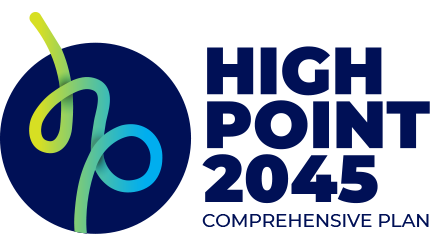About High Point 2045
High Point Mayor Cyril Jefferson and City Manager Tasha Logan Ford express their gratitude to the community for their contributions and engagement throughout the process.
Introduction

What is a comprehensive plan?
As the city’s long-range plan, the comprehensive plan establishes and sets the general direction for policymaking and investment for the next decade or more. It includes a conceptual roadmap for land use and development and provides the foundation for zoning and other land development regulations. The community’s vision, which is rooted in the community’s values, articulates the city’s future but does not determine it.
Comprehensive plans have the potential to provide communities with strategic direction on any number of things that are deemed important. High Point 2045 embraces this strategic approach by identifying the community’s priorities and outlining a framework for making decisions and managing growth consistent with the community’s vision.
The 2045 planning horizon was selected because it’s a duration long enough to change the trajectory of the city’s development and redevelopment pattern while avoiding weakening the community’s vision with short-term status-quo thinking. It’s recommended that the comprehensive plan be reviewed and updated, if needed, in 5 years and completely updated in 10 years.




How does a plan become reality?
A comprehensive plan’s vision becomes a reality only when a community is willing to make the choices that will bring it to fruition. How the community spends money, shapes regulations and policies, and decides “what goes where” will determine if the comprehensive plan is implemented.
When community leaders are committed to making decisions consistent with High Point 2045, it will be reflected in the following:
| Capital Improvement Plans (CIPs) | CIPs involve the annual allocation of resources to pay for improvements to public facilities, equipment, and infrastructure. The comprehensive plan should provide significant direction for CIPs. |
| Land Use and Design Regulations | The comprehensive plan provides policy guidance for the zoning code, which determines land use, density, and other characteristics of the built environment. After the plan is adopted, the code should be updated to reflect the plan. |
| Housing and Neighborhood Policy | Goals related to housing can be realized through the zoning code, as well as the allocation of resources to encourage specific types of investments in new or existing housing. |
| Economic Development Policy | Actions to promote economic activity of specific types and in specific places—to create jobs, build the tax base, or provide desired services—can be molded to reflect the plan. |
| Transportation and Infrastructure | The comprehensive plan should influence how federal, state, and local transportation and infrastructure dollars are allocated to improve conditions, boost capacity, or change how infrastructure is used. |
| Parks, Recreation and Open Space | The CIPs, general fund, and zoning code can all be used to support investment in parks and recreational facilities and preserving open space to meet quality of life goals expressed in the plan. |
| Small Area Plans | The comprehensive plan cannot provide detailed direction for what should happen on every block. However, subsequent plans or updated plans for specific neighborhoods, corridors, and areas can be developed that reflect the spirit and intent of the comprehensive plan at a more granular level. |
Strong connections to planning efforts already in place to ensure implementation
Planning is challenging work and implementing a plan’s strategies is far more challenging. It requires an ongoing funding commitment by the jurisdiction that initiates the planning effort – this may be in the form of a General Fund line item or a General Obligation bond, or both, to ensure the recommended work gets done.
High Point has a long history of high quality planning work that overlaps many city departments – from Planning and Development to Parks and Recreation to Community Development and Housing, etc. Simultaneous to the production of the comprehensive plan, an audit of many of these prior planning efforts was conducted to better understand not only the particular components associated with each of those efforts but also to see if implementation followed the planning work. It is noteworthy that 209 plans were part of this policy/plan audit.
The upside is there are recommendations from earlier planning efforts that fit almost seamlessly with those contained within this plan. Unfortunately, far too many of those recommendations have not been implemented. To the extent this plan can both capitalize on those related planning efforts and breathe new life into some of the recommendations, there is a greater chance that follow through and implementation will occur for this comprehensive planning effort.
What do we know
High Point is one of three primary cities in the Piedmont Triad region. Although High Point, Greensboro, and Winston-Salem have their own character and make unique contributions to the Triad, people are often served by all three. Due to proximity, it’s not unusual for someone to live in one city and work, shop or seek entertainment or recreation in another. To better understand how High Point is or is not changing on key metrics, it sometimes helps to consider or make a comparison to Greensboro and Winston-Salem or the Triad as a whole.
Glossary of Terms
This Glossary of Terms is primarily intended to help local officials and the public understand the terms that are commonly used in the process of making local land use and planning decisions. As in other professional disciplines, many of the terms used in planning and land use are technical. It is our hope that the glossary will be a handy reference that will make the topic of land use and planning less mysterious and more accessible to local officials and community residents alike.



